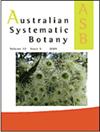桃金娘科变色龙科一个新的亚部落分类
IF 1.6
3区 生物学
Q4 EVOLUTIONARY BIOLOGY
引用次数: 1
摘要
摘要标题杨梅科Chamelauceae DC的一个新分类。,基于nr-ETS和cp-trnK以及atpB–rbcL间隔区序列的分子系统发育分析。已识别出11个子族,其中8个子族是新的。目前接受的亚种范围为Calytricinae Benth。和“Euchamelauceae Benth”(nom.inval.)被保留,后者在这里正式出版为Chamelaucinae Rye&Peter G.Wilson。Subribe Thryptomeninae Benth。通过创建新的亚群Alutinae Rye&Peter G.Wilson和Micromertinae Rye&Peter G.Wilson而缩小了大小。亚群Baeckeinae Schauer被缩减为一个属,被排除的属分布在新亚群Astarteinae Rye和Peter G.Wilson、Hysterobaeckeinae Rye&Peter G.Wilson,Rinziinae Rye&Peter G.Wilson和Stenostegiinae Rye和Peter G.Wilson。概述了Chamelauceae属和亚属的识别历史,并讨论了新分类的形态学证据。本文章由计算机程序翻译,如有差异,请以英文原文为准。
A new subtribal classification of Myrtaceae tribe Chamelaucieae
Abstract. A new classification of Myrtaceae tribe Chamelaucieae DC., derived from a molecular phylogenetic analysis based on nr ETS and cp trnK and atpB–rbcL spacer sequences, is presented. Eleven subtribes are recognised, eight of which are new. The currently accepted circumscriptions of subtribes Calytricinae Benth. and ‘Euchamelaucieae Benth.’ (nom. inval.) are retained, with the latter being formally published here as Chamelauciinae Rye & Peter G.Wilson. Subtribe Thryptomeninae Benth. is reduced in size by the creation of the new subtribes Alutinae Rye & Peter G.Wilson and Micromyrtinae Rye & Peter G.Wilson. Subtribe Baeckeinae Schauer is reduced to a single genus, with the excluded genera distributed in the new subtribes Astarteinae Rye & Peter G.Wilson, Hysterobaeckeinae Rye & Peter G.Wilson, Ochrospermatinae Rye & Peter G.Wilson, Rinziinae Rye & Peter G.Wilson and Stenostegiinae Rye & Peter G.Wilson. The history of recognition of the genera and subtribes of Chamelaucieae is outlined and supporting morphological evidence for the new classification discussed.
求助全文
通过发布文献求助,成功后即可免费获取论文全文。
去求助
来源期刊

Australian Systematic Botany
生物-进化生物学
CiteScore
3.10
自引率
12.50%
发文量
12
审稿时长
>12 weeks
期刊介绍:
Australian Systematic Botany is an international journal devoted to the systematics, taxonomy, and related aspects of biogeography and evolution of all algae, fungi and plants, including fossils. Descriptive taxonomic papers should normally constitute a comprehensive treatment of a group. Short papers on individual species and nomenclatural papers must contain significant new information of broader interest to be considered. The prestigious L.A.S. Johnson Review Series is published. Other review articles will also be considered. All papers are peer reviewed.
Australian Systematic Botany is published with the endorsement of the Commonwealth Scientific and Industrial Research Organisation (CSIRO) and the Australian Academy of Science.
 求助内容:
求助内容: 应助结果提醒方式:
应助结果提醒方式:


